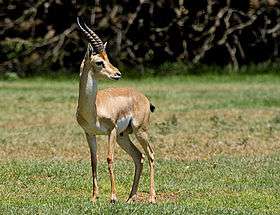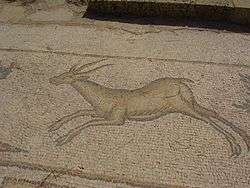Mountain gazelle
| Mountain gazelle[1] | |
|---|---|
 | |
| Mountain gazelle (male) | |
| Scientific classification | |
| Kingdom: | Animalia |
| Phylum: | Chordata |
| Class: | Mammalia |
| Order: | Artiodactyla |
| Family: | Bovidae |
| Subfamily: | Antilopinae |
| Genus: | Gazella |
| Species: | G. gazella |
| Binomial name | |
| Gazella gazella (Pallas, 1766) | |
The mountain gazelle (Gazella gazella) is a species of gazelle widely but unevenly distributed.
Physical Description
Mountain gazelles are one of the few mammals in which both sexes have horns. Males have significantly larger horns with rings around them. Females will also have horns, but they will be thinner and shorter. Along with the horns, mountain gazelles are sexually dimorphic, meaning that males are larger than females. A wild male can range from 17-29.5kg, while females are 16-25kg in weight.[3] Mountain gazelles can reach running speeds up to 80 km/h (50 mph).[4]
Population and Range
Mountain gazelles are most abundant in Israel, but are found in parts of Jordan, Turkey, and Palestine. While there are not accurate estimates of the number of individuals in the wild, Israel estimated there to be only 1,210 endangered gazelles in their country.[5] Less than 3,000 mountain gazelles are left within their natural range.
Habitat
Gazelles have adapted to live in dry, desert-like conditions.[6] They spend most of their time at the top of mountains and hills Living in an annual average temperature of 21-23°C, gazelles prefer to bed on the tops of the hills/mountains to avoid the heat during the day. Around dawn and dusk, these mammals will be found traversing the hills to eat in light forests, fields, or desert plateaus.[7] It is less well adapted to hot, dry conditions than the Dorcas gazelle, which appears to have replaced the mountain gazelle through some of its range during the late Holocene in a period of climatic warming.
Ecology
The mountain gazelle is a diurnal species, they are awake during the day and sleep at night. They are also very territorial and with their herds, but typically stay in herds of three to eight individuals. There are three main groups in the mountain gazelle community: maternity herds, bachelor male herds, or territorial solitary males.[8]
Survival and Reproduction
In the wild, mountain gazelles rarely survive past the age of eight but can live up to 15 years in captivity when taken care of. By 12 months, a female gazelle can begin breeding. [9] For males, 18 months is when they will start breeding.[10] Being polygamous[11], not spending their lives with one other individual, mountain gazelles' typical breeding season is during the early winter months. Females will give birth to one offspring per year mostly between the months of April and May.[12] A few days prior to giving birth the mother will leave her herd and live in solitary. For up to two months, the mother and her offspring will stay by themselves while the mother watches out for predators. Common predators include foxes, jackals, and wolves that will try to attack the fawn. [13] While young males will stay with their mother for only six months before departing to a herd of young males, young females will sometimes join their mother with a herd.[14]
Food
Its range coincides closely with that of the acacia trees that grow in these areas. It is mainly a grazing species, though this varies with food availability. They can survive for long periods of time without a water source. Instead, they acquire freshwater from succulents and dew droplets from plants.[15]
History
In 1985, a large population of mountain gazelles built up through game conservation in two Israeli reserves, in the southern Golan Heights and Ramat Yissachar, was decimated by foot and mouth disease. To prevent such occurrences, a plan was drawn up to stabilize the female population at 1,000 in the Golan and 700 in Ramat Yissachar.[16]
Threats and Conservation
Mountain gazelles were hunted throughout Israel because they were thought of as a pest until 1993. Their numbers are still low for multiple reasons. In some areas, they face predation from feral dogs and jackals. They also face poachers for their skin, meat, and horns. As with other animals, mountain gazelles are harmed by road accidents, habitat degradation, and habitat fragmentation. Mountain gazelles are now a legally protected species, but often there is not enough enforcement to protect the species.[17]
Subspecies
The Levantine mountain gazelle – G. gazella[18] – resides largely in three areas: the Golan Heights, West Bank, Ramot Naftali and the Galilee. In the coastal plain, there is a small population of gazelles but the numbers are decreasing in the wake of accelerated urbanization. The population decreased greatly throughout its natural range in the first part of the 20th century due to poaching.[19] but increased thereafter thanks to conservation efforts.[19] Gazelle Valley in Jerusalem preserves a small herd.[20]
The Hatay mountain gazelle is the subspecies which lives the northeast. They live in Syrian border of Turkey in Hatay Province.[21]
Historically, some others such as the Cuvier's gazelle (G. cuvieri) were included as a subspecies,[22] but recent authorities consistently treat them as separate species.[23]
References
- ↑ Grubb, P. (2005). "Gazella gazella". In Wilson, D.E.; Reeder, D.M. Mammal Species of the World: A Taxonomic and Geographic Reference (3rd ed.). Johns Hopkins University Press. pp. 637–722. ISBN 978-0-8018-8221-0. OCLC 62265494.
- ↑ IUCN SSC Antelope Specialist Group (2017). "Gazella gazella". The IUCN Red List of Threatened Species. IUCN. 2017: e.T8989A50186574. doi:10.2305/IUCN.UK.2017-2.RLTS.T8989A50186574.en. Retrieved 12 January 2018.
- ↑ Lee, Kari. "Gazella gazella mountain gazelle". Animal Diversity Web. Retrieved 9 April 2018.
- ↑ Lee, K. "Gazella gazella". Animal Diversity Web. Retrieved 22 August 2011.
- ↑ "Gazella gazella (Ha'tsviha'Israeli, Idmi, Mountain Gazelle)". www.iucnredlist.org. Retrieved 2018-04-30.
- ↑ "Gazelle gazelle". The IUCN Red List. Retrieved 26 April 2018.
- ↑ Lee, Kari. "Gazella gazella mountain gazelle". Animal Diversity Web. Retrieved 9 April 2018.
- ↑ Lee, Kari. "Gazella gazella mountain gazelle". Animal Diversity Web. Retrieved 9 April 2018.
- ↑ Baharav, Dan. "NOTES ON THE POPULATION STRUCTURE AND BIOMASS OF THE MOUNTAIN GAZELLE, GAZELLA GAZELLA GAZELLA".
- ↑ Lee, Kari. "Gazella gazella mountain gazelle". Animal Diversity Web. Retrieved 9 April 2018.
- ↑ Baharav, Dan. "NOTES ON THE POPULATION STRUCTURE AND BIOMASS OF THE MOUNTAIN GAZELLE, GAZELLA GAZELLA GAZELLA".
- ↑ Lee, Kari. "Gazella gazella mountain gazelle". Animal Diversity Web. Retrieved 9 April 2018.
- ↑ "Mountain gazelle (Gazella gazella)". Wildscreen Arkive.
- ↑ Lee, Kari. "Gazella gazella mountain gazelle". Animal Diversity Web. Retrieved 9 April 2018.
- ↑ Lee, Kari. "Gazella gazella mountain gazelle". Animal Diversity Web. Retrieved 9 April 2018.
- ↑ Mountain gazelle management in northern Israel in relation to wildlife disease control. (PDF) . oie.int.
- ↑ "Gazelle gazelle". The IUCN Red List. Retrieved 26 April 2018.
- ↑ IUCN SSC Antelope Specialist Group. (2008). Gazella gazella. The IUCN Red List of Threatened Species 2008. doi:10.2305/IUCN.UK.2008.RLTS.T8970A12942665.en
- 1 2 Kaplan, D. (December 2002). "Langfristige Bestandsschwankungen der Edmigazelle (Gazella gazella gazella) in Nordisrael". Zeitschrift für Jagdwissenschaft. Springer Berlin / Heidelberg. 48 (Supplement 1): 167–171. doi:10.1007/BF02192405.
- ↑ Jaffee-Hoffman, Maayan (3 November 2016). "Galloping Forward". Jerusalem Post. Retrieved 4 November 2016.
- ↑ Wildlife Extra News – 250 endangered Mountain gazelles found in Turkey – First record in Turkey. Wildlifeextra.com. Retrieved on 2015-09-25.
- ↑ ADW: Gazella gazella: INFORMATION. Animaldiversity.org. Retrieved on 2015-09-25.
- ↑ Mallon, D.P. & Cuzin, F. (2008). "Gazella cuvieri". IUCN Red List of Threatened Species. Version 2008. International Union for Conservation of Nature. Retrieved 18 August 2015.
External links
| Wikimedia Commons has media related to Gazella gazella. |
| Wikispecies has information related to Gazella gazella |

